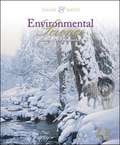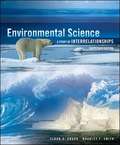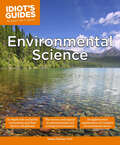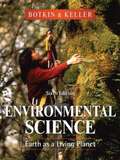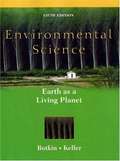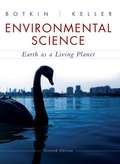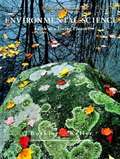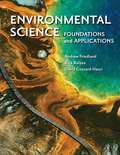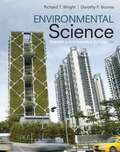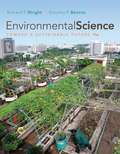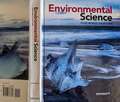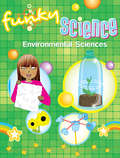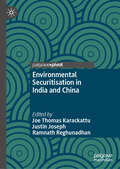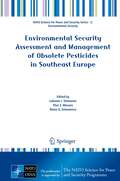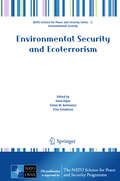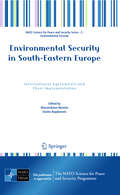- Table View
- List View
Environmental Science: A Study of Interrelationships (10th edition)
by Bradley F. Smith Eldon D. EngerThe book is an introductory environmental science text covering the basic concepts.
Environmental Science: A Study of Interrelationships (Thirteenth Edition)
by Bradley F. Smith Eldon D. EngerThe book provides information and the conceptual framework needed to understand complex issues so that readers can comprehend the nature of environmental problems and formulate their own views.
Environmental Science: An In-Depth Look at Earth’s Ecosystems and Diverse Inhabitants (Idiot's Guides)
by James DaurayEnvironmental science is an integrated, interdisciplinary field that combines the study of ecology, physics, chemistry, biology, soil science, geology, atmospheric science, and geography. It is among the top 10 most popular Advanced Placement examinations taken by high school seniors in an effort to receive postsecondary college credit. Idiot's Guides: Environmental Science provides a step-by-step review of the disciplines that comprise environmental science, helping students grasp the basic concepts, internalize the information, and prepare for exams. Features include: The basics and history of the human relationship with the natural environment. The ways species grow, change, and interact. A detailed description of the earth's ecosystems, including deserts, grasslands, forests, and aquatic ecosystems. The effects of economics and agriculture on the environment. The various types of energy humans use, as well as how its production impacts the earth's ecosystems, with a focus on renewable energy sources. The ill effects of a growing population, including pollution, toxins, bacteria, waste, and global warming/climate change.
Environmental Science: Earth As a Living Planet
by Daniel B. Botkin Edward A. KellerUpdated and revised to include the latest research in the field, the new Sixth Edition of Environmental Science continues to present a balanced analytical and interdisciplinary approach to the field. This approach equips readers with a solid scientific background in environmental science, so they can think through environmental issues and make their own decisions. Five central themes are weaved throughout the book: Human Population Growth, Sustainability, A Global Perspective, An Urban World, and Science and Values.
Environmental Science: Earth as a Living Planet
by Daniel B. Botkin Edward A. KellerAn introductory textbook that presents the most important concepts in the study of the environment from an analytical and interdisciplinary perspective, and encourages students to formulate their own thoughts about environmental problems. Annotation c. by Book News, Inc. , Portland, Or.
Environmental Science: Earth as a Living Planet
by Daniel B. Botkin Edward A KellerEnvironmental Science: Earth as a Living Planet provides an up-to-date introduction to the study of the environment. Information is presented from an analytical and interdisciplinary perspective from which we must view environmental issues in order to deal successfully with them. The goal is to teach the students how to think through environmental issues.
Environmental Science: Earth as a Living Planet
by Daniel B. Botkin Edward A. KellerFor more than two decades, Botkin has been active in the application of ecological science to environmental management. Updated and revised to include the latest research in the field, the new edition of 'Environmental Science' continues to present a balanced analytical and interdisciplinary approach to the field.
Environmental Science: Earth as a Living Planet (3rd edition)
by Daniel B. Botkin Edward A. KellerAn introductory textbook that presents the most important concepts in the study of the environment from an analytical and interdisciplinary perspective, and encourages students to formulate their own thoughts about environmental problems. Annotation C. by Book News, Inc., Portland, Or.
Environmental Science: Ecology and Human Impact
by Leonard Bernstein Alan Winkler Linda Zierdt-WarshawEnvironmental Science: Ecology And Human Impact. As the title dictates, this book works on ecology people and the effects of their activities on the environment. It takes the readers in an in-depth study by introducing the earth and its the composition to the reader; second, the People and the Environment all this aiming towards understanding the environment and promoting a sustainable future.
Environmental Science: Foundations and Applications
by Andrew Friedland Rick Relyea David Courard-HauriCreated for non-majors courses in environmental science, environmental studies, and environmental biology, Environmental Science: Foundations and Applications emphasizes critical thinking and quantitative reasoning skills. Students learn how to analyze graphs, measure environmental impact on various scales, and use simple calculations to understand key concepts.With a solid understanding of science fundamentals and how the scientific method is applied, students are able to evaluate information objectively and draw their own conclusions.
Environmental Science: Toward A Sustainable Future (Ninth Edition)
by Tony WrightOur ecological footprint weighs heavily on Earth's natural resources the "ecosystem capital" that provides the goods and services that sustain human life and economic well-being.
Environmental Science: Toward a Sustainable Future
by Richard Wright Dorothy BoorseFor introductory courses in Environmental Science, Environmental Studies, and Environmental Biology. Known for its currency and readability, this text focuses on enabling students to critically evaluate the latest environmental issues and to apply that understanding to situations and events in their everyday lives. <p><p>It explores the interactions of humans within the natural environment and probes issues thoroughly examining their scientific basis, their history, and society's response. The authors discuss sustainable development and public policy in terms of how they shape the present and future.
Environmental Science: Toward a Sustainable Future (10th Edition)
by Richard T. Wright Bernard J. NebelAs the field of environmental science continues to evolve, this highly readable guide presents a full spectrum of views and information to help readers evaluate issues and make informed decisions. Reflects the changing environmental scene worldwide, with a wide range of viewpoints and information from the latest sources. Places new emphasis on issues such as emerging diseases like avian flu; the 4 th World Water Forum; the "gene revolution;" the Endangered Species Act controversy; restoration of the Everglades, and the 2005 Global Forest Resources Assessment. Strives for a balance between pure science and the political, social, and historical perspectives of environmental affairs. For those interested in learning more about environmental science.
Environmental Science: Toward a Sustainable Future (11th edition)
by Richard T. Wright Dorothy F. BoorseBy emphasizing the memorable themes of science, sustainability and stewardship, the Eleventh Edition of this popular textbook helps you understand the science behind environmental issues and what you can do to build a more sustainable future.
Environmental Science: Working with the Earth
by G. Tyler Miller Jr.With an emphasis on the concept of sustainability, this interdisciplinary textbook looks at how nature works and how things in nature are interconnected. Material from science, economics, political science, and environmental ethics is integrated throughout the text. Some 80 brief case studies illustrate specific environmental problems and explore possible solutions. New topics covered in the 11th edition include reconciliation ecology, ownership of water resources, and bioterrorism. Annotation ©2005 Book News, Inc. , Portland, OR (booknews. com)
Environmental Science: Working with the Earth (11th edition)
by G. Tyler MillerThis edition places increased emphasis on science-based approaches that interact with political solutions to address environmental problems, offers greater integration of economic and environmental topics, and stresses the shift from large centralized sources of power to a dispersed array of smaller micropower plants. There are two new chapters on community ecology and geology, and expanded coverage of aquatic biodiversity. Tyler is president of Earth Education and Research, and professor of human ecology at St. Andrews Presbyterian College.
Environmental Science: Your World, Your Turn
by Jay WithgottPhenomena drives student engagement in the all new Environmental Science - coming Back to School 2020! An Anchoring Phenomena launches scientific inquiry in every topic supported by a Claim-Evidence-Reasoning activity and Problem-Based Learning project.Students make sense of the Anchor with 19 Investigative Phenomena Case Studies. These authentic, real-world applications of Environmental Science excite students and inspire their passion for the environment.
Environmental Sciences Funky Science (Funky Science)
by Kirsten HallSmart and savvy girls will love discovering the secrets of science! Funky Science: Environmental Sciences has loads of cool, creative experiments presented in a fun and accessible way, relating to topics that girls love. Go green as you learn about plants, save the planet as you compost and recycle, uncover the wonders of weather, and explore the world of Environmental Sciences! All experiments are developed with science teachers and provide the science behind the activity along with parental guidance symbols and glossaries of Wonder Words.
Environmental Securitisation in India and China
by Joe Thomas Karackattu Ramnath Reghunadhan Justin JosephThis book examines how emerging environmental challenges are situated within existing International Relations (IR) theoretical understandings of &‘security&’. As governments in the Global South undertake policy interventions to mitigate the impact of increasing climatic changes and yearn to achieve human-nature harmony, one can observe similar patterns of responses chiefly due to the ecology-economy dichotomy in these states and their societies. In this context, it brings to the readers various aspects of the theory and practice of state interventions in the form of environmental securitisation in the Global South majorly under four themes (encompassing theory and policy processes). Chapters in this volume explicate connections between the environment and International Relations Theory, securitisation in developing countries, state society and the environment in India and China and lastly, public participation and environmental policymaking. It presents a comprehensive and coherent overview of the politics of securitisation in India and China, two prominent economies in the Global South. Faculty and researchers who work on non-western International Relations theory and non-traditional security threats, policy practitioners and experts in environmental policymaking, and students of IR and Comparative Politics, chiefly, will benefit from this book.
Environmental Security Assessment and Management of Obsolete Pesticides in Southeast Europe
by Biana G. Simeonova Fliur Z. Macaev Lubomir I. SimeonovThe present work is a fine contribution to the broad field of environmental security in the context of risk assessment and management of obsolete pesticides for the region of Southeast Europe. The purpose of this book is to evaluate the existing knowledge of improper disposal of obsolete pesticides in the region, to estimate the associated impact on environmental health, and to develop recommendations to mitigate or eliminate threats posed to the environment, biodiversity and human life. The issues discussed in the book include: reviews of the transport and fate of pesticides and associated contaminated materials in different environmental media and identification of the principal sources, emission routes and patterns of environmental pollution with pesticides; a recognition of the most suitable methods for environmental sampling analysis and sample preparation; an evaluation of the current methods and techniques for chemical and mass analysis of environmental and biological samples and discussion of the metrological and quality aspects of trace analyses; a characterization of the environmental and human health impacts of pesticide pollution, the health effects associated with acute and chronic exposure and the use of epidemiological data for risk assessment; a revision of the existing chemical safety regulations and strategies for protection and management of obsolete pesticide stocks; a survey of the international conventions, directives and standards concerning pesticide use.
Environmental Security and Ecoterrorism
by Hami Alpas Simon M. Berkowicz Irina ErmakovaIn recent years, the concept of environmental security has been adapted to include preparedness for acts of ecoterrorism. This latter term has now become synonymous with environmental terrorism where the perpetrator uses the environment as a weapon to harm an opponent. The intended outcome is usually large-scale deaths, severe damage to the environment, and instilling fear in the general population. This book explores various facets of ecoterrorism including the role of the state in pursuing and maintaining environmental security, a review of the concept of ecoterrorism, food security challenges and weaknesses, technological countermeasures to enable rapid detection or response, and existing pollution sources and hazards that may serve as targets for terrorist acts. In sum, this volume provides a useful overview for both the layperson and experienced researchers.
Environmental Security in South-Eastern Europe
by Massimiliano Montini Slavko BogdanovicAuthored by international experts from academia, international organizations, governments and NGOs, this book highlights the main environmental security issues in the South-East European (SEE) countries, with a particular focus on climate change and water management. The common goal of the authors was to provide a reliable evaluation of whether existing legal regimes and correct implementation of applicable international treaties may contribute to reducing environmental security risks in the region. In-depth analyses and assessment of major challenges in compliance, serve as a firm ground which such evaluation is based on. This volume is recommended for public officials, legal practitioners and consultants. Its interest may also extend beyond the SEE countries, serving as a case-study of a broader and paradigmatic relevance of the analysis and management of environmental and security issues in a trans-boundary context.
